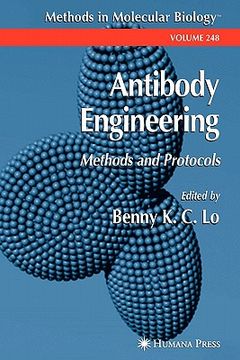Share
antibody engineering: methods and protocols
Benny K. C. Lo
(Illustrated by)
·
Humana
· Paperback
antibody engineering: methods and protocols - Lo, Benny K. C.
Choose the list to add your product or create one New List
✓ Product added successfully to the Wishlist.
Go to My Wishlists
Origin: U.S.A.
(Import costs included in the price)
It will be shipped from our warehouse between
Tuesday, June 18 and
Thursday, July 04.
You will receive it anywhere in United Kingdom between 1 and 3 business days after shipment.
Synopsis "antibody engineering: methods and protocols"
The exquisite binding specificity of antibodies has made them valuable tools from the laboratory to the clinic. Since the description of the murine hybridoma technology by Köhler and Milstein in 1975, a phenomenal number of mo- clonal antibodies have been generated against a diverse array of targets. Some of these have become indispensable reagents in biomedical research, while others were developed for novel therapeutic applications. The attractiveness of an- bodies in this regard is obvious--high target specificity, adaptability to a wide range of disease states, and the potential ability to direct the host's immune s- tem for a therapeutic response. The initial excitement in finding Paul Ehrlich's "magic bullet," however, was met with widespread disappointment when it was demonstrated that murine antibodies frequently elicit the human anti-murine an- body (HAMA) response, thus rendering them ineffective and potentially unsafe in humans. Despite this setback, advances in recombinant DNA techniques over the last 15-20 years have empowered the engineering of recombinant antibodies with desired characteristics, including properties to avoid HAMA. The ability to p- duce bulk quantities of recombinant proteins from bacterial fermentation also fueled the design of numerous creative antibody constructs. To date, the United States Food and Drug Administration has approved more than 10 recombinant antibodies for human use, and hundreds more are in the development pipeline. The recent explosion in genomic and proteomic information appears ready to deliver many more disease targets amenable to antibody-based therapy.
- 0% (0)
- 0% (0)
- 0% (0)
- 0% (0)
- 0% (0)
All books in our catalog are Original.
The book is written in English.
The binding of this edition is Paperback.
✓ Producto agregado correctamente al carro, Ir a Pagar.

